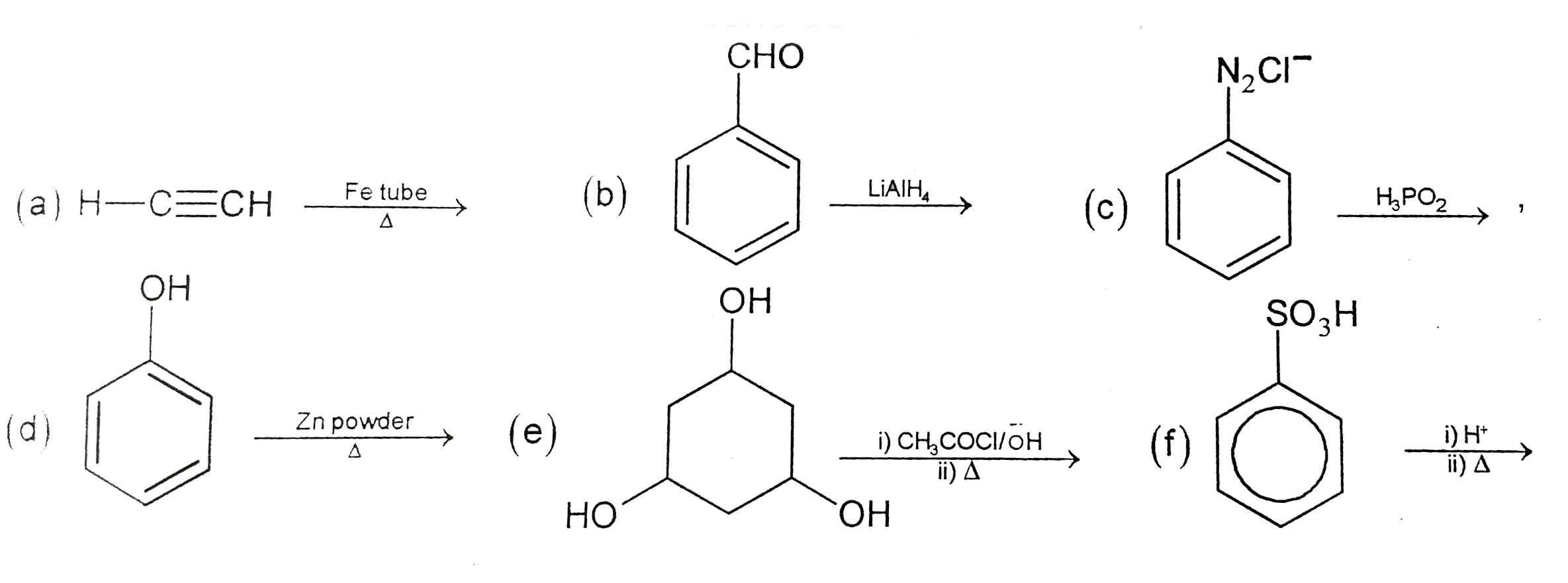Combustion of benzene gives products as Solution in Telugu
6CO2+6H2O
3CO2+6H2O
CO2+6H2O
6CO2+3H2O
The correct Answer is:D
CXHY+[X+Y4]O2→XCO2+YH2O
Topper's Solved these Questions
- HYDROCARBONSBOOK - AAKASH SERIESCHAPTER - HYDROCARBONSEXERCISE - LECTURE SHEET ( EXERCISE-V (AROMATICITY AND ACID-BASE PROPERTIES , AROMATIC ELECTROPHILLIC SUBSTITUTION(LINKED COMPREHENSION TYPE QUESTIONS(PASSAGE-I))))
5 Videos
- HYDROCARBONSBOOK - AAKASH SERIESCHAPTER - HYDROCARBONSEXERCISE - LECTURE SHEET ( EXERCISE-V (AROMATICITY AND ACID-BASE PROPERTIES , AROMATIC ELECTROPHILLIC SUBSTITUTION(INTEGER TYPE QUESTIONS)))
4 Videos
- HYDROCARBONSBOOK - AAKASH SERIESCHAPTER - HYDROCARBONSEXERCISE - LECTURE SHEET ( EXERCISE-V (AROMATICITY AND ACID-BASE PROPERTIES , AROMATIC ELECTROPHILLIC SUBSTITUTION( STRAIGHT OBJECTIVE TYPE QUESTION )))
13 Videos
- GENERAL ORGANIC CHEMISTRYBOOK - AAKASH SERIESCHAPTER - GENERAL ORGANIC CHEMISTRYEXERCISE - QUESTIONS FOR DESCRIPTIVE ANSWERS
35 Videos
- HYDROGEN AND ITS COMPOUNDSBOOK - AAKASH SERIESCHAPTER - HYDROGEN AND ITS COMPOUNDSEXERCISE - QUESTIONS FOR DESCRIPTIVE ANSWERS
20 Videos
Similar Questions
Electrophilic substitution on mono substituted benzene is determined by electronic effects +1, -M groups are ortho, para directors, where as -1,-M groups are meta directions. When there is a competition between inductive and mesomeric effects, the latter wins over. Electrophilic substitution on disubstituted benzene is determined by the combined effect of both groups. Usually activating group wins over deactivating group. When one of the groups has a lone pair of electrons, that will determine the product formation. Usually a third group will not enter the position in between the two existing groups due to steric reasons.
Major products of nitration of acetanilide is:
View SolutionHow many of the following reagents can give benzene from benzene diazonium salt?
H2O,CH3CH2OH,H3PO4,H3PO2,HCHO,CH3COOH,RCHO
View SolutionWhich of the following reactions, aromatic characters retained ?
View SolutionMention the hybridisation stste of each carbon in the following compounds.
CH3−CH=C=O,CH3−C≡C−CH3,CH3COCH3andCH2=CHCN
View SolutionWhy the use of hard water is disadvantages?
View SolutionThe heat of combustion of benzene is -3264 kJmol^(-1) . The heat evolved in the combustion of 39g of benzene will be………………. .
View SolutionNumber of reaction which gives Benzene as major products?

View SolutionHeat of combustion of benzene is 718 K. cals. When 39 gms of benzene undergoes combustion, the heat liberated is
View SolutionThe combustion of benzene (l) gives CO_(2)(g) and H_(2)O(l) . Given that heat of combustion of benzene at constant volume is –3263.9 kJ mol^(–1) at 25^(@)C , heat of combustion (in kJ mol^(–1) ) of benzene at constant pressure will be (R = 8.314 JK–1 mol–1)
View SolutionThe combustion of benzene (l) gives CO_(2) (g) and H_(2)O (l) . Given that heat of combustion of benzene at constant volume is -3263.9 kJ * mol^(-1) at 25^(@) C , heat of combustion ( in kJ * mol^(-1)) of benzene at constant pressure will be - (R = 8.314 J * K^(-1) * mol^(-1) )
View Solutionबेन्जीन दहन पर, CO2(g) तथा H2O(l) देता है। दिया है, 25∘C ताप तथा स्थिर आयतन पर बेन्जीन के दहन ऊष्मा −3263.9 किलोजूल मोल−1 है। स्थिर दाब पर बेन्जीन के दहन की ऊष्मा होगी (R=8.314Jmol−1)
View SolutionBenzene reacts with chlorine in sunlight to give a final product
View SolutionThe combustion of benzene (l) gives CO2(g) and H2O(l).Given that heat of combustion of benzene at constant volume is −3263.9kJmol−1 at 25∘C, heat of combustion (in kJmol−1) of benzene at constant pressure will be (R=8.314JK−1mol−1).
View SolutionThe combustion of benzene (l) gives CO2(g) and H2O(l). Given that heat of combustion of benzene at constant volume is –3263.9kJmol–1 at 25∘C, heat of combustion (in kJmol–1) of benzene at constant pressure will be
(R = 8.314 JK–1 mol–1)
View SolutionThe heat of combustion of benzene at 27∘C and at constant volume is -3245 KJ. Then the heat of combustion of benzene at the same temperature and at constant pressure
View Solution
